Another Second Saturday and time for a Lowcountry Unfiltered adventure. This was actually a cross-over event, with as many participants from the Church of the Double-Bladed Paddle group on Facebook as LCU participants. Granted, two of us were in both groups, but still. The venue was one for the books – Turkey Creek and Stevens Creek in McCormick County turned out to be a waterway with an identity crisis. It didn’t know if it wanted to be Upcountry or Lowcountry.
I’ve known about the Turkey Creek-Stevens Creek paddling trail for a LONG time. It’s been one of those paddling venues that I’ve wanted to try, but just haven’t had a chance to attempt. Water levels have to be just right, and it is a bit out of the way.
The waterway itself is somewhat unique. It’s above the Fall Line, so it has the characteristics of an Upcountry river – a good current with rocks and occasional shoals that can be…challenging. However, botanically it’s in a transitional zone. There are large cypress trees and other vegetation more typical of a Lowcountry river. So, in short, rapids and cypress.
Truth is, I didn’t have much solid information about this river. One source listed the rapids as Class II(III), which is about the same as the lower Green River. Others had it listed as a Class I. We had also gotten reports of log jams blocking the river. Without good data, I didn’t know what gear to bring, or even what boat to bring. Normally I’d bring my Perception Torrent for whitewater, but it’s a wet boat. It was supposed to be chilly, so that would mean additional gear for paddling while cold and wet. Ultimately, I decided on my Pungo. I made sure to pack my machete if I needed to help clear a strainer.
Saturday morning was cold and windy. I left before sunrise and headed down through Greenwood and McCormick Counties toward Modoc. We had a unique meeting spot. We had made a connection with Chad Quinn through the Church of the Double-Bladed Paddle Facebook group, and he had invited us down to come see his new business, Cloudfire Outfitters. We would be joined by another COTDBP participant, Tim Brown. Tim was from Savannah, and had been camping down on Clark Hill Reservoir. He would meet us there.
I pulled into Modoc early. An SUV with a kayak on top pulled onto the highway behind me, and I suspected that it might be Tim. I was a bit early, though, and wanted to check conditions at Modoc Bridge. I took Highway 23 east to the Stevens Creek crossing. There was a parking area west of the bridge at a trail head. However, the trail didn’t look like it went to the river. The information kiosk made it look like it wouldn’t.
I drove across the bridge and saw nothing but steep banks and no obvious access. When I came back across the bridge I saw a set of steps leading down to the river, but no obvious way to get down there. It looked like we would be hauling boats at a tricky take-out.
I headed on back to Modoc and found the SUV I’d spotted earlier parked at Cloud Fire. Chad, Tim, and one of Chad’s neighbors were chatting out front.
Soon Marc Epting joined us, and Chad gave us a tour of his business. Cloudfire was opening for business, but the grand opening was yet to come. Even so, Chad had sit-on-top kayaks and gear for rent under a covered shed. Rental rates were listed outside on one of the windows. Chad had even added a small lending library outside.
Inside, though, was where the cool stuff was. Chad had built several skin-on-frame kayaks and had them on display. The frames were cedar, and the skin was a thin Kevlar coated with epoxy. He had finished these out with leather thongs and other accoutrements to make it look old and authentic. One was a Disko Bay design, but I don’t remember what the second completed design was.
Chad had a third kayak without the skin, just the frame.
Chad also makes Greenland paddles. He had several of these for sale hanging from the rafters.
Soon Matt joined us. He was by himself. He couldn’t convince any of our other regular LCU paddlers to come along. I guess the threat of whitewater had scared some of them off. Chad showed him some of the things he had already shown us.
Chad had a map of the river, and had been checking on river information for us, but didn’t really have information about rapids, etc. Chad is more of a flat water paddler, and I’m not sure he had paddled our route. Certainly the beautiful kayaks he had in his shop weren’t the right kind of boat for this trek. Regardless, we appreciated the information that he was able to provide. Chad even loaned us one of his Greenland paddles to try out.
While it was great meeting Chad and seeing his shop, the time at Cloudfire threw us a bit behind on our launch time. We drove over to Modoc Bridge. Marc had scouted the area earlier in the week, and had found an easily overlooked trail down to the stairs at the river. There were a few logs across the trail, and the steps themselves looked steep, but doable.
We decided to leave Tim’s SUV at the take out. He wasn’t going to paddle his 17′ boat, but a smaller one he had brought with him. Turns out it’s a modular boat that comes in two pieces. I’d not seen one like that.
The shuttle was longer and more complicated than usual because it involved an intermediate stop, some dirt roads, and some steep inclines. We decided to park Matt’s Jeep at about the halfway point. We would leave his stove and our lunch with the Jeep so that we didn’t have to worry about the added weight on the river. This spot overlooked the confluence of Turkey and Stevens Creeks.
Our put-in was at Key Bridge on Turkey Creek. The main (current) bridge was a steel girder bridge like Modoc Bridge over Stevens Creek. An even older steel girder bridge is now a pedestrian bridge along a trail. Our put-in was actually a bit downstream from that, down another dirt road. We unloaded the boats and hauled them down the steep bank to a small beach area.
We had thought about launching at the 283 bridge further upstream, and it’s a good thing we didn’t. A massive log jam blocked the river right at our put in. It would have required a portage. Of course, this just made us all the more anxious for what was downstream.
We got underway, much, much later than one of our usual trips. We didn’t even get on the water until 11:30 am. The water was chilly, and the current moderately quick, but it felt so good to be back on the water. Matt started out with Chad’s Greenland paddle.
Right away the unique characteristics of this river jumped out at us. There were huge cypress trees with surrounding cypress knees clinging to steep banks of angled granite. It had a somewhat alien feel, but the scenery was absolutely stunning.
This video gives you a bit of a feel for the river at the start.
So far the trip was progressing at a relaxed pace, similar to our Edisto trips. That gave us a chance to get to know our new fellow paddler. We had met Tim online through the Church of the Double-Bladed Paddle and Look at the Front of my Kayak groups on Facebook. Tim’s posts were the ones that inspired me to set my goal to track my paddling mileage this year. Two years ago he paddled 400 miles, last year 500, and this year he’s aiming for 600. Quite an ambitious goal.
Tim is a high school Spanish teacher and football coach at an inner-city school in Savannah. He said he also has a daughter majoring in music education, so we had quite a bit to talk about. Tim mostly paddles the coastal waters around Savannah.
Tim’s posts on Facebook always include a GPS track and a photo of the front of his kayak with his iconic pirate flag. The flag was designed by an art teacher at his school and includes crossed paddles and a skull with the hat he always wears. The flag was on his 17′ boat, and not the modular craft he was paddling today.
The sun seemed almost unnaturally bright. It was crisp, with a biting wind. We watched the tops of the cypress whip around when caught by gusts. Since we were down between steep banks in somewhat of a gorge we were sheltered from the wind. Laura pointed out later that had the wind shifted directions, we might have found ourselves in a wind tunnel.
The wind had another effect. Normally I listen for the sound of rapids as we approach. This time the roaring wind obscured the sound of the water. It would blend with and mask the sound, so that we were on our first rapid without any auditory warning.
This first rapid was a short 2″ drop over a few rocks – a set of shoals typical for Upstate rivers. There was a clear route through, so we all made it with no problem. I would put this one at Class I at best. Just about all of the rapids we encountered were like this.
The video clip below is from a later rapid, but it gives you an idea of the type of whitewater we encountered – fairly tame stuff, but it could be tricky for the uninitiated. As it was our group encountered no problems through these small shoals. I’m sure a change in water level would change their difficulty. We just had to watch out for rocks just below the water line that might snag a boat.
We paddled along like this for a couple of hours – smooth current punctuated by an occasional shoal. One thing that struck us was how incredibly remote this was. There were NO houses, or even apparent farms along the banks. Turkey Creek runs through Sumter National Forest, and the Stevens Creek Natural Area bounds the west bank of the river. We saw herons, kingfishers, and turtles, but not much other wildlife was out and about in the cool wind. I could imagine later in spring you would see more birds with warmer weather.
We had been worried about deadfalls and strainers. We did find our route blocked twice. The first time was a tree that was just below the surface, with a large root ball down in the water to the right. We’ve had success building up speed and “jumping” over logs like this in the past, and that’s what Matt attempted this time. Unfortunately, it was too high and he got stuck for a bit. I was able to find a clear but narrow path around the root ball to the right. The others followed me, and Matt was able to free himself and join us.
The next blockage was a massive cypress that formed a bridge across the river. Fortunately this one was high enough that we could paddle under without even having to limbo. I could see it being a problem with higher water levels, though.
After a couple of hours of paddling we finally reached our lunch stop at the confluence of Turkey Creek with Stevens Creek. We were later than usual with lunch. Normally we have the stove and food packed with us and can stop when and where we want, but this time we were locked into a specific location. At least we had avoided the “5 Minute Rule,” which states that no matter where you stop for lunch, there’s a better spot 5 minutes downstream.
We parked the kayaks on a beach and scrambled up the steep bank to Matt’s Jeep, slipping a bit in the mud along the way. The brats and sauerkraut were a welcome repast.
Suitably refreshed we continued on our trek. With the addition of water from Turkey Creek, Stevens Creek was a good bit wider. Overall, though, the characteristics remained the same. There were some rapids, but fewer than we had encountered on Turkey Creek. Since the river was a bit wider, the winds also now reached down to the water level, but by this time they weren’t too bad.
Matt let me try out Chad’s Greenland paddle. I used it for awhile on some of the flat spots, but I couldn’t imagine trying to maneuver with it in a rapid. I’ll grant that it was light, comfortable, and beautifully made, but I didn’t quite get the increasing popularity for these paddles. It felt like it had no bite, and kind of felt like I was trying to paddle with a 2X4. I also realized I was in the wrong boat and at the wrong venue. I think these are meant for long distances in a light touring craft, not whitewater in a heavy rec boat. I switched back to my Werner paddle fairly quickly.
I had marked multiple rapids in my GPS, but I had derived these locations from Google Earth. In some cases the imagery had been taken when water levels were lower and the rocks more exposed. Often we would paddle right over an area I had marked with barely a ripple.
That’s not to say that we didn’t have ANY rapids on this section.
In fact, the steepest drop and in my opinion the best rapid on the river was on this section, and, by a strange twist of fate, I was the only one of our group to run it. The water flowed around a small island. A narrow channel led to the left, and there was a steep drop across the wider part of the river. First Marc, then Matt and Tim opted for the narrower channel. I’m not sure why – perhaps they thought it would be a fast, more interesting run. Whatever their reasoning, I decided I’d just tackle the rapids. These shots show our approach.
Here I am in the middle of the rapid.
Here’s the video clip. The rapid doesn’t look like much from this angle, and it really wasn’t anything. I’ve tackled much more difficult stuff on other rivers, just not in this type of boat. And you hear me say the word “bucket” at the beginning, and not some other similar-sounding expletive. That’s my story, and I’m sticking to it.
At the bottom of the rapid I looked back up the narrow channel to see what fate had befallen my comrades. Turns out they had gotten stuck behind a downed tree and had to portage around it. I think I took the better path.
Reunited, we continued on. The scenery and remoteness continued to amaze us. We found one cypress with roots spreading out across the steep bank similar to the “Medusa Tree” in Falls Park in Greenville.
We were paddling along peacefully, and the sight of the stairs on the right bank caught us a bit by surprise. We came around a bend and the Modoc Bridge loomed high overhead. We didn’t want to go too far, though. There was a nice rapid right under the bridge, and if we went past that we would have difficulty getting back.
A small tributary stream entered from the right. Matt and I thought it might be interesting to explore, but it choked down soon after entering.
Now we began the arduous task of hauling out the boats. The first step was higher above the river than we expected, so even getting out of the kayaks was a challenge. I managed to lash my boat to the step to stabilize it, then kind of scoot out onto the bottom step. Then we had to drag the boats up the steep steps.
This is when having a gear-laden boat is NOT an advantage. I’m sure Matt was glad he had brought his smaller boat and not the larger one he usually has.
From the top of the stairs we had a muddy poison-ivy infested slog up a trail and over logs. The rapids were nothing compared to this. We managed, though. We left the boats on down the trail a bit and headed out to retrieve our cars. Since Matt’s vehicle was at the halfway point, he made it back to the boats first, and had them dragged mostly back when we got back with the other trucks.
We said our goodbyes to Tim, then Matt, Marc and I headed to Edgefield to get dinner at a little Mexican place.
Apart from the steep banks and long shuttle, it had been a near-perfect day on the river. This one is definitely a keeper, but you need to pay attention to conditions. At lower water this might be unrunnable. In all, my GPS said we had paddled 8.2 miles. Tim’s read 9.13. I’m not sure what caused the discrepancy in distance, but I’ll stick with mine.
The one thing I regret is that we didn’t have time to explore the cool steel girder bridge at Key Bridge. There were lots of over interesting old buildings and things to see in the surrounding countryside as we made the shuttles, but we just didn’t have the opportunity to stop and take photos. I want to come back down here just to explore those areas.
I posted over 300 photos from this trip to my Flickr account and several video clips. I’ll end this with a slide show. Enjoy!
One quick update: A comment from Tom Watkins on Facebook provided more information about the geology of the area…
Another interesting feature of Turkey Creek is that just below its confluence with Stevens Creek its waters flow along an earthquake fault. The western bank is a steep up thrust zone while the left or eastern bank is a distinct flood plain-very interesting region! Got to get back down soon before the water drops too low.
The river is quite interesting, indeed.


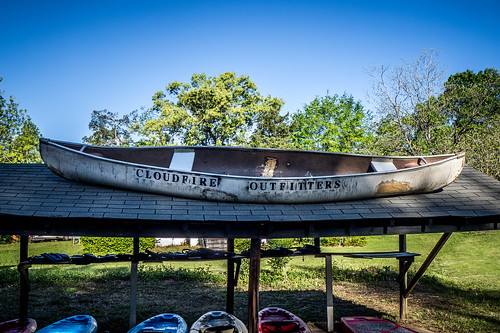









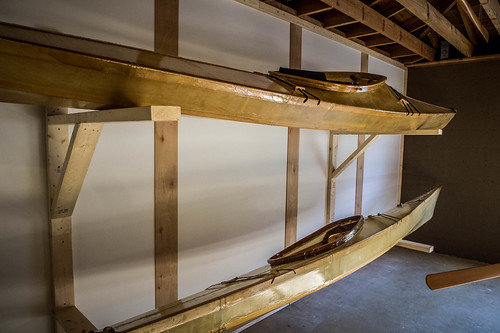














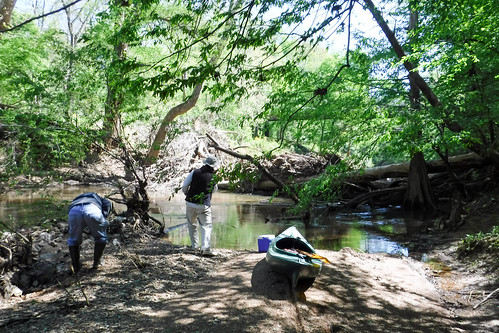



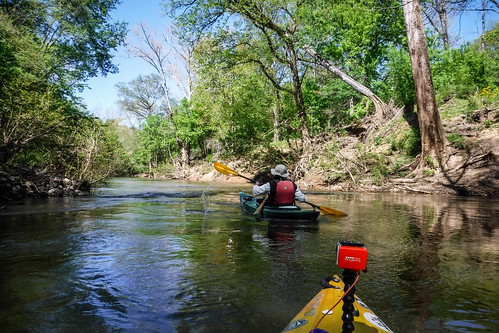
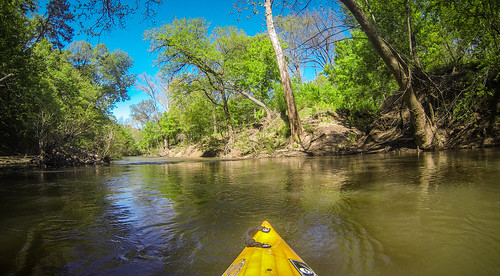

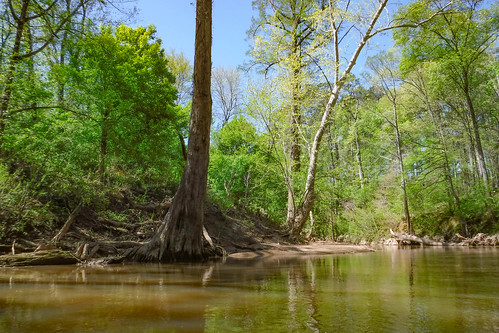




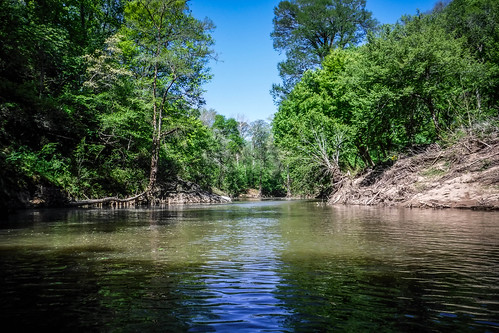


















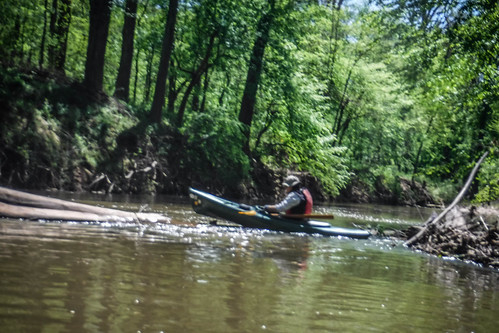


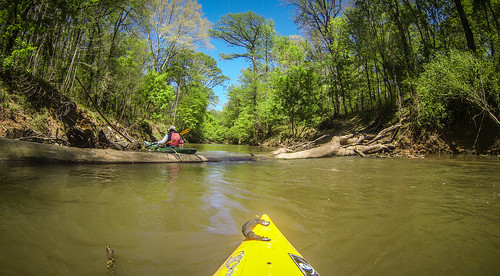




















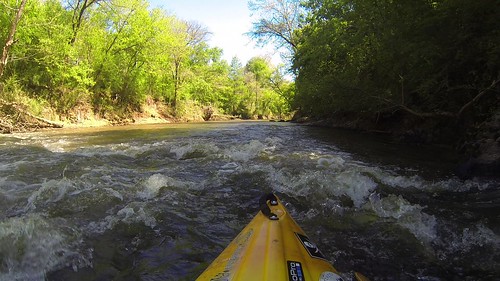


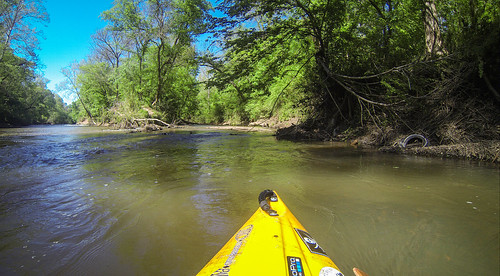
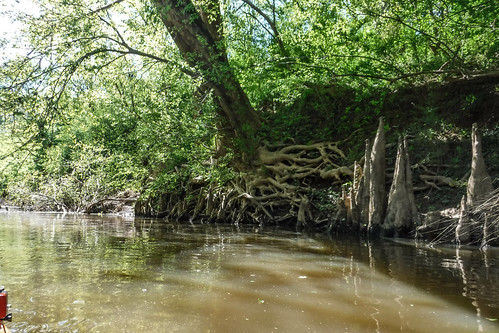

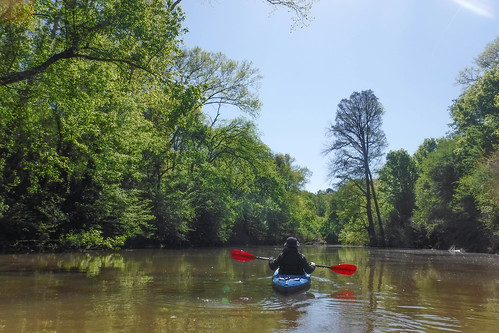











What a trip! One for the “bucket list.” 😉
Great post and trip. Unique creeks. Above 4 feet height at Modoc and flow above 400 would have been a more thrilling ride. I will go again.
Marc